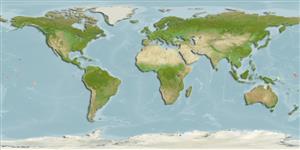Environment: milieu / climate zone / depth range / distribution range
Ecología
marino demersal; rango de profundidad 6 - 55 m (Ref. 48238). Tropical
Distribución
Países | Áreas FAO | Ecosistemas | Ocurrencias, apariciones | Point map | Introducciones | Faunafri
Eastern Central Pacific: Kiribati. Appears to be endemic to this part of the Pacific.
Tamaño / Peso / Age
Maturity: Lm ? range ? - ? cm
Max length : 21.2 cm SL macho / no sexado; (Ref. 48238); 14.3 cm SL (female)
Short description
Claves de identificación | Morfología | Morfometría
Espinas dorsales (total) : 5; Radios blandos dorsales (total) : 21; Espinas anales: 1; Radios blandos anales: 17; Vértebra: 30. Predorsal scales about 15. Small and cycloid scales on cheek; on body ctenoid. No serrae or spines on edges of opercular bones except a single stout spine on opercle. Body elongate, depth 5.7-6.2 in SL; whitish with 8 narrow dark bars, all but first and last broadly expanded dorsally to a Y-shape. Body cylindrical anteriorly, the width slightly greater than depth. Third or 4th dorsal spines longest; membrane of 5th dorsal spine connected directly across from spine tip to first soft ray. Caudal fin slightly rounded, upper corner projecting as a short, broad-based filament in adults. Mouth slightly oblique, the lower jaw projecting.
Collected from sand or sand and rubble substrata in both lagoon and seaward reef areas. Large and easily approached. Apparently a protogynous hermaphrodite (Ref. 48238).
Life cycle and mating behavior
Maturities | Reproducción | Spawnings | Egg(s) | Fecundities | Larva
Randall, J.E. and J.E. McCosker, 2002. Parapercis lata, a new species of sandperch (Perciformes: Pinguipedidae) from the central Pacific. Proc. Calif. Acad. Sci. 53(8):87-93. (Ref. 48238)
IUCN Red List Status (Ref. 130435)
Threat to humans
Harmless
Human uses
Herramientas
Special reports
Download XML
Fuentes de Internet
Estimates based on models
Preferred temperature (Ref.
123201): 26.2 - 28.5, mean 27.2 °C (based on 32 cells).
Phylogenetic diversity index (Ref.
82804): PD
50 = 0.5000 [Uniqueness, from 0.5 = low to 2.0 = high].
Bayesian length-weight: a=0.00692 (0.00311 - 0.01538), b=3.06 (2.88 - 3.24), in cm total length, based on LWR estimates for this Genus-body shape (Ref.
93245).
Nivel trófico (Ref.
69278): 3.6 ±0.4 se; based on size and trophs of closest relatives
Resiliencia (Ref.
120179): Medio, población duplicada en un tiempo mínimo de 1.4-4.4 años (Preliminary K or Fecundity.).
Fishing Vulnerability (Ref.
59153): Low vulnerability (16 of 100).
Nutrients (Ref.
124155): Calcium = 221 [137, 384] mg/100g; Iron = 1.18 [0.74, 1.86] mg/100g; Protein = 17.3 [15.2, 19.1] %; Omega3 = 0.162 [0.090, 0.283] g/100g; Selenium = 50.1 [26.4, 94.8] μg/100g; VitaminA = 27.7 [10.2, 71.3] μg/100g; Zinc = 1.45 [1.06, 1.98] mg/100g (wet weight);
